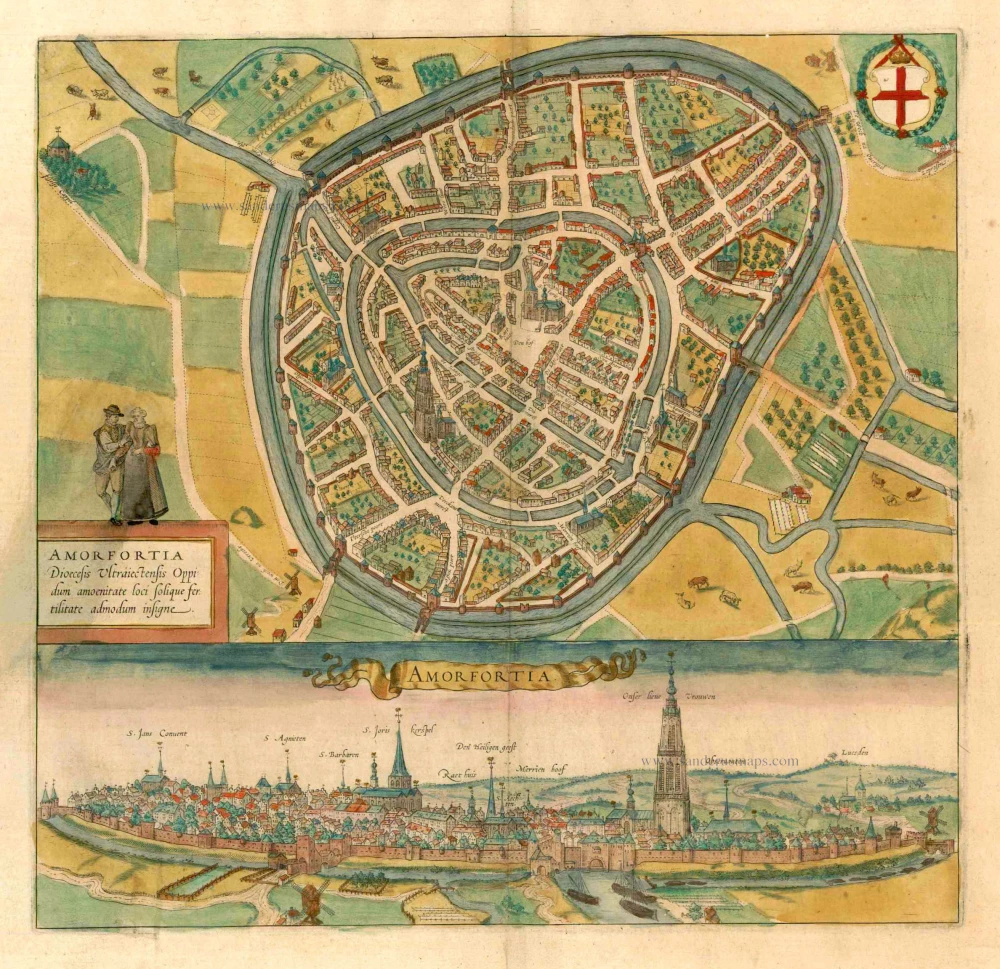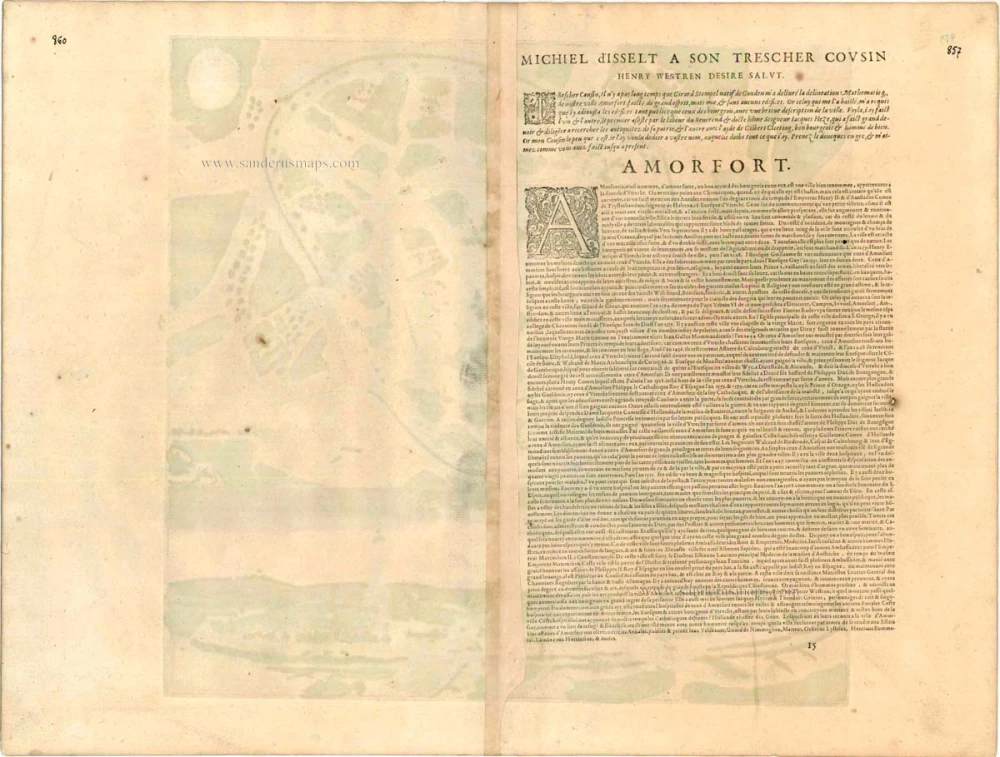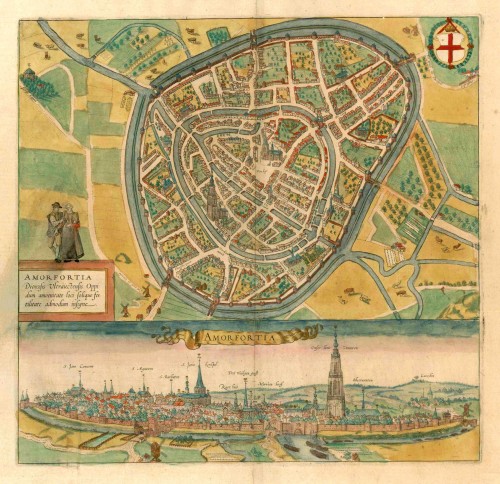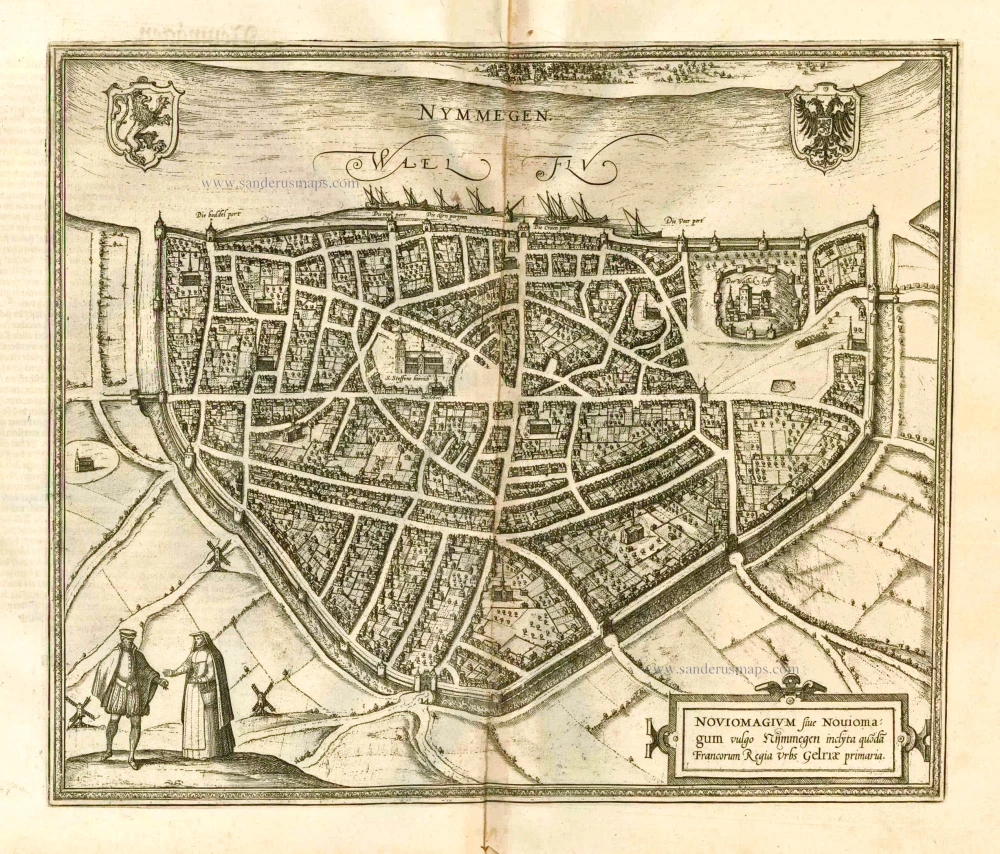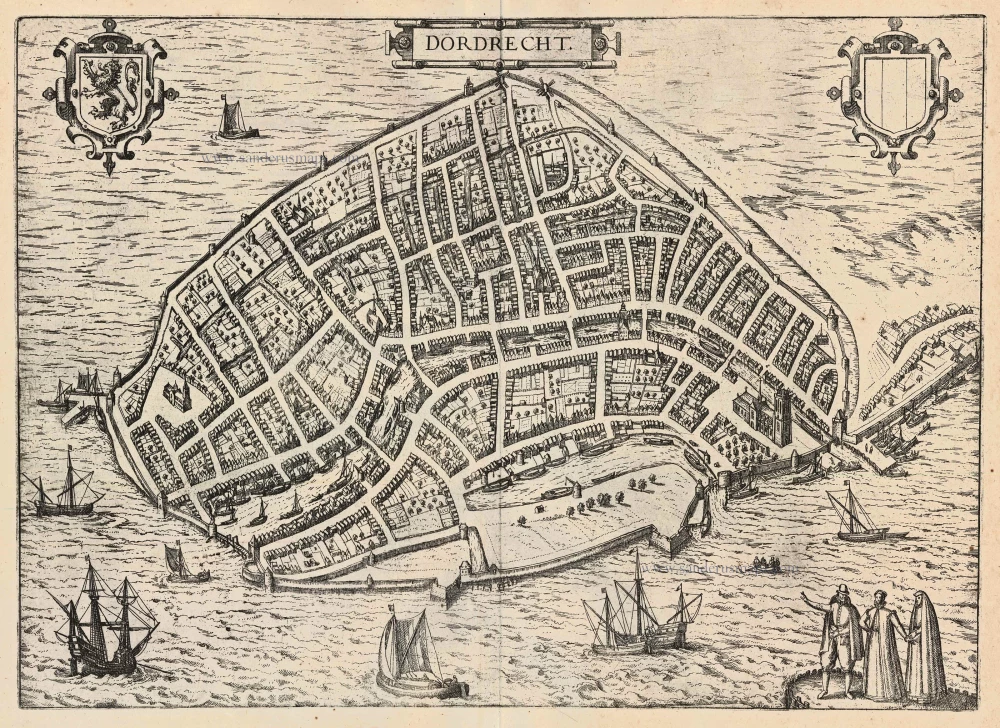Amersfoort by Braun Georg & Hogenberg Frans c. 1593
TRANSLATION OF CARTOUCHE TEXT: Amersfoort, a town in the Diocese of Utrecht, highly distinguished by its pleasant location and the fecundity of its soil.
COMMENTARY BY BRAUN: "Amersfoort, which has its name ab amore forti, that is, by steadfast love or concord among its citizens, is a renowned city in the bishopric of Utrecht. [...] Its old ring walls and moats show that it was once quite small, but then grew steadily so that a new town was built around the old one and it thus became greatly expanded."
This plate contains a plan and a view. The first is a bird's-eye plan of the town from the south. Several streams flow into the double canal ring, and the Eem drains away in the northwest. The centre of the town is dominated by the main square with the three-nave Gothic Sint-Joriskerk. To the southwest of it can be seen the spire of the late Gothic Onze-Lieve-Vrouwe-Kerk, which is almost 100 m high. A settlement here is first documented in 1028, and it was granted a municipal charter in 1259; it had flourishing brewing and textile industries and became a member of the Hanseatic League. Because of the expanding population, new fortifications were built between 1450 and 1561, which can be seen here with its many towers and gates, including the Koppelpoort, where the Eem flows out of the town. The second view shows the town from an elevated position in the north. On the right is the Eem, with the Koppel gate in the city, and close to it, rising above the rest, the tower of Our Lady. Left of centre is the Sint-Joriskerk, and Amersfoort Hill can be seen in the background. (Taschen)
Braun G. & Hogenberg F. and the Civitates Orbis Terrarum.
The Civitates Orbis Terrarum, also known as the 'Braun & Hogenberg', is a six-volume town atlas and the most excellent book of town views and plans ever published: 363 engravings, sometimes beautifully coloured. It was one of the best-selling works in the last quarter of the 16th century. Georg Braun, a skilled writer, wrote the text accompanying the plans and views on the verso. Many plates were engraved after the original drawings of a professional artist, Joris Hoefnagel (1542-1600). The first volume was published in Latin in 1572 and the sixth in 1617. Frans Hogenberg, a talented engraver, created the tables for volumes I through IV, and Simon van den Neuwel made those for volumes V and VI. Other contributors were cartographers Daniel Freese and Heinrich Rantzau, who provided valuable geographical information. Works by Jacob van Deventer, Sebastian Münster, and Johannes Stumpf were also used as references. Translations appeared in German and French, making the atlas accessible to a broader audience.
Since its original publication of volume 1 in 1572, the Civitates Orbis Terrarum has left an indelible mark on the history of cartography. Seven more editions followed the first volume in 1575, 1577, 1582, 1588, 1593, 1599, and 1612. Vol.2, initially released in 1575, saw subsequent editions in 1597 and 1612. The subsequent volumes, each a treasure trove of historical insights, graced the world in 1581, 1588, 1593, 1599, and 1606. The German translation of the first volume, a testament to its widespread appeal, debuted in 1574, followed by the French edition in 1575.
Several printers were involved: Theodor Graminaeus, Heinrich von Aich, Gottfried von Kempen, Johannis Sinniger, Bertram Buchholtz, and Peter von Brachel, all of whom worked in Cologne.
Georg Braun (1541-1622)
Georg Braun, the author of the text accompanying the plans and views in the Civitates Orbis Terrarum, was born in Cologne in 1541. After his studies in Cologne, he entered the Jesuit Order as a novice, indicating his commitment to learning and intellectual pursuits. In 1561, he obtained his bachelor's degree; in 1562, he received his Magister Artium, further demonstrating his academic achievements. Although he left the Jesuit Order, he continued his studies in theology, gaining a licentiate in theology. His theological background likely influenced the content and tone of the text in the Civitates Orbis Terrarum, adding a unique perspective to the work.
Frans Hogenberg (1535-1590)
Frans Hogenberg was a Flemish and German painter, engraver, and mapmaker. He was born in Mechelen as the son of Nicolaas Hogenberg.
By the end of the 1560s, Frans Hogenberg was employed upon Abraham Ortelius's Theatrum Orbis Terrarum, published in 1570; he is named an engraver of numerous maps. In 1568, he was banned from Antwerp by the Duke of Alva and travelled to London, where he stayed a few years before emigrating to Cologne. He immediately embarked on his two most important works, the Civitates, published in 1572 and the Geschichtsblätter, which appeared in several series from 1569 until about 1587.
Thanks to large-scale projects like the Geschichtsblätter and the Civitates, Hogenberg's social circumstances improved with each passing year. He died as a wealthy man in Cologne in 1590.
Amorfortia Diocesis Ultraiectensis Oppidum amoenitate loci solique fertilitate admodum insigne.
Item Number: 15424 Authenticity Guarantee
Category: Antique maps > Europe > The Netherlands - Cities
Old, antique bird’s-eye view plan of Amersfoort by Braun Georg & Hogenberg Frans.
Title: Amorfortia Diocesis Ultraiectensis Oppidum amoenitate loci solique fertilitate admodum insigne.
Date of the first edition: 1588.
Date of this map: c. 1593.
Copper engraving, printed on paper.
Size (not including margins): 360 x 372mm (14.17 x 14.65 inches).
Verso: French text.
Condition: Original coloured, waterstain at left.
Condition Rating: A.
From: Liber Quartus - Livre Quatriesme des Principales Villes du Monde, 1593. (Van der Krogt 4, 41:3.4(1593))
TRANSLATION OF CARTOUCHE TEXT: Amersfoort, a town in the Diocese of Utrecht, highly distinguished by its pleasant location and the fecundity of its soil.
COMMENTARY BY BRAUN: "Amersfoort, which has its name ab amore forti, that is, by steadfast love or concord among its citizens, is a renowned city in the bishopric of Utrecht. [...] Its old ring walls and moats show that it was once quite small, but then grew steadily so that a new town was built around the old one and it thus became greatly expanded."
This plate contains a plan and a view. The first is a bird's-eye plan of the town from the south. Several streams flow into the double canal ring, and the Eem drains away in the northwest. The centre of the town is dominated by the main square with the three-nave Gothic Sint-Joriskerk. To the southwest of it can be seen the spire of the late Gothic Onze-Lieve-Vrouwe-Kerk, which is almost 100 m high. A settlement here is first documented in 1028, and it was granted a municipal charter in 1259; it had flourishing brewing and textile industries and became a member of the Hanseatic League. Because of the expanding population, new fortifications were built between 1450 and 1561, which can be seen here with its many towers and gates, including the Koppelpoort, where the Eem flows out of the town. The second view shows the town from an elevated position in the north. On the right is the Eem, with the Koppel gate in the city, and close to it, rising above the rest, the tower of Our Lady. Left of centre is the Sint-Joriskerk, and Amersfoort Hill can be seen in the background. (Taschen)
Braun G. & Hogenberg F. and the Civitates Orbis Terrarum.
The Civitates Orbis Terrarum, also known as the 'Braun & Hogenberg', is a six-volume town atlas and the most excellent book of town views and plans ever published: 363 engravings, sometimes beautifully coloured. It was one of the best-selling works in the last quarter of the 16th century. Georg Braun, a skilled writer, wrote the text accompanying the plans and views on the verso. Many plates were engraved after the original drawings of a professional artist, Joris Hoefnagel (1542-1600). The first volume was published in Latin in 1572 and the sixth in 1617. Frans Hogenberg, a talented engraver, created the tables for volumes I through IV, and Simon van den Neuwel made those for volumes V and VI. Other contributors were cartographers Daniel Freese and Heinrich Rantzau, who provided valuable geographical information. Works by Jacob van Deventer, Sebastian Münster, and Johannes Stumpf were also used as references. Translations appeared in German and French, making the atlas accessible to a broader audience.
Since its original publication of volume 1 in 1572, the Civitates Orbis Terrarum has left an indelible mark on the history of cartography. Seven more editions followed the first volume in 1575, 1577, 1582, 1588, 1593, 1599, and 1612. Vol.2, initially released in 1575, saw subsequent editions in 1597 and 1612. The subsequent volumes, each a treasure trove of historical insights, graced the world in 1581, 1588, 1593, 1599, and 1606. The German translation of the first volume, a testament to its widespread appeal, debuted in 1574, followed by the French edition in 1575.
Several printers were involved: Theodor Graminaeus, Heinrich von Aich, Gottfried von Kempen, Johannis Sinniger, Bertram Buchholtz, and Peter von Brachel, all of whom worked in Cologne.
Georg Braun (1541-1622)
Georg Braun, the author of the text accompanying the plans and views in the Civitates Orbis Terrarum, was born in Cologne in 1541. After his studies in Cologne, he entered the Jesuit Order as a novice, indicating his commitment to learning and intellectual pursuits. In 1561, he obtained his bachelor's degree; in 1562, he received his Magister Artium, further demonstrating his academic achievements. Although he left the Jesuit Order, he continued his studies in theology, gaining a licentiate in theology. His theological background likely influenced the content and tone of the text in the Civitates Orbis Terrarum, adding a unique perspective to the work.
Frans Hogenberg (1535-1590)
Frans Hogenberg was a Flemish and German painter, engraver, and mapmaker. He was born in Mechelen as the son of Nicolaas Hogenberg.
By the end of the 1560s, Frans Hogenberg was employed upon Abraham Ortelius's Theatrum Orbis Terrarum, published in 1570; he is named an engraver of numerous maps. In 1568, he was banned from Antwerp by the Duke of Alva and travelled to London, where he stayed a few years before emigrating to Cologne. He immediately embarked on his two most important works, the Civitates, published in 1572 and the Geschichtsblätter, which appeared in several series from 1569 until about 1587.
Thanks to large-scale projects like the Geschichtsblätter and the Civitates, Hogenberg's social circumstances improved with each passing year. He died as a wealthy man in Cologne in 1590.

